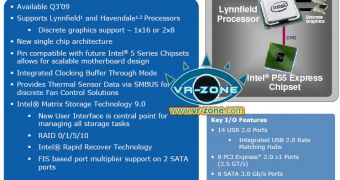More information on Intel's P55 Express chipset, also known under the codename "Ibex peak", has emerged on the Web, and it seems that the giant chip manufacturer will stick to the original plan of launching its latest product in the third quarter of 2009, with support for the future Intel microprocessors codenamed Lynnfield and Havendale, a quad-core and a dual-core, respectively. Of the two, the latter will be the first CPU to come to the market featuring an integrated GPU.
The Ibex peak with Lynnfield/Havendale, which seems to be internally known as Summitlake, will come as a replacement for the traditional Southbridge in the future Intel architecture. The P55 Express chipset will also be known as Platform Controller Hub (PCH) and it is basically a single chip solution that includes all the I/O features that ICH has. The new chipset will still include Intel's DMI chip-to-chip interconnect instead of QuickPath Interconnect (QPI), which is found on the company's ready-to-come X58 chipset.
According to VR-Zone, Ibex peak will also include support for discrete graphics in x16 setup, as well as for SLI and CrossFire in x8/x8 configuration. On the connectivity side, the future P55 Express chipset will come with 14 USB 2.0 ports, 8 PCIe 2.0 x1 ports, 6 SATA 3.0Gb/s ports, Gigabit Ethernet and Intel Matrix Storage Technology 9.0 (IMST 9.0) with FIS-based port multiplier support. Since the LGA1160 quad-core Lynnfield and dual-core Havendale microprocessors are designed for the mainstream market area, the P55 Express chipset should come as an interesting choice for many users.
In other related news, Intel is planning to launch five new 35W desktop Core 2 Duo processors by the end of the year. The T9800, Q9000, P9600, T9550 and T8700, will be priced $530, $348, $348, $316 and $241 respectively, in thousand-unit tray quantities. With the introduction of these new CPUs, Intel will be able to cut the price of its top-end Core 2 Duo P8600 processor in early 2009.

 14 DAY TRIAL //
14 DAY TRIAL //